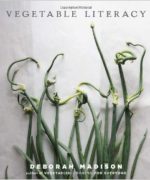Vegetable Literacy: Cooking and Gardening with Twelve Families from the Edible Plant Kingdom, with over 300 Deliciously Simple Recipes. / Deborah Madison. Published by Ten Speed Press, Berkeley, California, 2013.

Home from the market, grocery store or local farmer’s market, and the large bunches of leaves, roots and herbs were too lovely to pass up. But cooking and savoring the goodness of a big bunch of carrots would mean a large dinner party. Tonight. And assuming that serving carrots would be every guest’s idea of a great feast, how could you wow them into vegetarian bliss over a mountain of orange roots?
Deborah Madison’s Vegetable Literacy will advance your knowledge about vegetables and increase your recipe cache to abundant. She has here effectively described the twelve categories of vegetables in their families (a botanical term), and given directions for cooking them; but also, to speed you on your way to becoming well-versed as well as a good cook, Madison provides named varieties to plan your seed-purchasing adventures. You will want to plant a garden! Your harvest will be flavorful as it is likely to be plentiful, especially, Madison notes, if you culture your soil as well as your plants, as most vegetables require rich, moist soil in order to thrive and make those substances and compounds which are the hallmark of healthy eating.
Memories of dinner at our house many years ago consist of an almost daily helping (and seconds if you wanted) of green peas, plain or with butter. I still love them, along with green beans, edamame (soy beans), and peanuts. Fava beans are good, of course, but their skins need to be peeled, and eaten early: because of their size they carry lots of starch. They’re a Mediterranean import in our gardens and kitchens, so like lentils, they pair well with lemon juice, olive oil and garlic (and of course artichokes, peas, leeks and asparagus). Madison is generous with her dressing recipes, especially vinaigrettes, which she advises as companions to lentils, for example. To make a Meyer Lemon and Shallot Vinaigrette, you need one shallot, the zest and the juice of a Meyer Lemon, Dijon mustard, sea salt and extra virgin olive oil. The mustard and olive oil are added to the first few ingredients, after letting them mellow for 10 minutes (p. 22).
Alright. In the interest of full disclosure, many of Madison’s recipes require an egg, or four or five (if you look at the cakes). So that makes it difficult, certainly more challenging, for those lacto-vegetarians or vegans among us. It would be exciting to veganize a recipe that calls for egg and milk ingredients, because some of the proposed flavor combinations are unique. Consider Rye Honey Cake with Five Spice Powder and Dates, or Carrot Almond Cake with Ricotta Cream.
Madison’s borrowed ideas from Asian and European, and from South American kitchens.
Her recipes are cosmopolitan and use updated methods and equipment, yet do not require expensive tools. Unusual ingredients can be substituted, something which her style of recipe invention encourages. Each of the twelve categories of vegetables carries the names of all the edible plants in that family. For example there are the carrot, mint, cabbage, grass and legume families, and then the goosefoot and amaranth, knotweed, nightshade and cucurbit families. The sunflower, lily and morning glory families are known by the familiar names of flowers. You might know the Sunflower family from flowers such as chrysanthemums, cosmos, daisy, echinacea, goldenrod, and of course sunflowers. Although Asian cultures may drink chrysanthemum tea, American Indian tribes use echinacea as medicine, and Russian people revere sunflower seeds like we do peanuts; recipes tend to center on artichokes, chicory and endive, bitter greens, and tarragon.
As you may have guessed, vegetables are entertaining at least because of their variety of texture and flavor and the range of possibilities is nearly unlimited, especially when combined with grains or pulses. Madison’s text is apologetic about lists of nutritional data, which she declines to provide, but each chapter contains a discussion of the plants’ cultural background and benefits, like the sources of vitamins and the vegetable’s properties which protect our health. Her experience is real and honest, coming in direct contact with the freshly grown, and freshly harvested from her garden, and her excitement is infectious. Just leafing through her book, a wanna-be gardener just may commit to spending time and effort growing vegetables. She says of a garden that “a lively patch of earth stitches us firmly to the world at large”—a connection with life that could only be healthful and stress-reducing.
Follow


